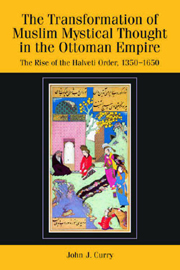 The Transformation of Muslim Mystical Thought in the Ottoman Empire
The Transformation of Muslim Mystical Thought in the Ottoman Empire Book contents
- Frontmatter
- Contents
- List of Maps and Figures
- Abbreviations for Frequently Cited Works in the Text
- Acknowledgments
- Note on Transliteration
- Map 1
- Map 2
- INTRODUCTION: ON THE STUDY OF OTTOMAN MYSTICAL TRADITIONS
- PART I THE RISE AND SPREAD OF THE HALVETİ ORDER FROM ITS ORIGINS THROUGH THE ELEVENTH/SEVENTEENTH CENTURY
- PART II THE EVOLUTION OF A HALVETİ SUB-BRANCH: THE LIFE AND CAREER OF ŞAcBÂN-I VELİ AND HIS FOLLOWERS IN THE KASTAMONU REGION
- PART III DEFENDING THE CULT OF SAINTS IN ELEVENTH/SEVENTEENTH-CENTURY KASTAMONU: TRANSFORMING THE ŞAcBÂNİYE ORDER UNDER cÖMER EL-FUɔÂDÎ
- INTRODUCTION
- 6 cÖMER EL-FUɔÂDÎ AS SUFI ASPIRANT AND HAGIOGRAPHER: THE ROAD TO ŞAcBÂNİYE SUCCESSION
- 7 INSCRIBING THE ŞAcBÂNİYE ORDER ONTO KASTAMONU'S LANDSCAPE
- 8 THE POLITICAL AND DOCTRINAL LEGACY OF cÖMER EL-FUɔÂDÎ
- CONCLUSION: WHAT CAN THE ŞAcBÂNİYE TEACH US ABOUT TRANSITIONS IN THE EARLY MODERN PERIOD OF WORLD HISTORY?
- Appendix I
- Appendix II
- Works Cited and Further Reading
- Index of Persons
- Index of Places
- Index of Subjects
6 - cÖMER EL-FUɔÂDÎ AS SUFI ASPIRANT AND HAGIOGRAPHER: THE ROAD TO ŞAcBÂNİYE SUCCESSION
from PART III - DEFENDING THE CULT OF SAINTS IN ELEVENTH/SEVENTEENTH-CENTURY KASTAMONU: TRANSFORMING THE ŞAcBÂNİYE ORDER UNDER cÖMER EL-FUɔÂDÎ
Published online by Cambridge University Press: 12 September 2012
- Frontmatter
- Contents
- List of Maps and Figures
- Abbreviations for Frequently Cited Works in the Text
- Acknowledgments
- Note on Transliteration
- Map 1
- Map 2
- INTRODUCTION: ON THE STUDY OF OTTOMAN MYSTICAL TRADITIONS
- PART I THE RISE AND SPREAD OF THE HALVETİ ORDER FROM ITS ORIGINS THROUGH THE ELEVENTH/SEVENTEENTH CENTURY
- PART II THE EVOLUTION OF A HALVETİ SUB-BRANCH: THE LIFE AND CAREER OF ŞAcBÂN-I VELİ AND HIS FOLLOWERS IN THE KASTAMONU REGION
- PART III DEFENDING THE CULT OF SAINTS IN ELEVENTH/SEVENTEENTH-CENTURY KASTAMONU: TRANSFORMING THE ŞAcBÂNİYE ORDER UNDER cÖMER EL-FUɔÂDÎ
- INTRODUCTION
- 6 cÖMER EL-FUɔÂDÎ AS SUFI ASPIRANT AND HAGIOGRAPHER: THE ROAD TO ŞAcBÂNİYE SUCCESSION
- 7 INSCRIBING THE ŞAcBÂNİYE ORDER ONTO KASTAMONU'S LANDSCAPE
- 8 THE POLITICAL AND DOCTRINAL LEGACY OF cÖMER EL-FUɔÂDÎ
- CONCLUSION: WHAT CAN THE ŞAcBÂNİYE TEACH US ABOUT TRANSITIONS IN THE EARLY MODERN PERIOD OF WORLD HISTORY?
- Appendix I
- Appendix II
- Works Cited and Further Reading
- Index of Persons
- Index of Places
- Index of Subjects
Summary
cÖmer el-Fuɔâdî would likely have been a transitional figure in the history of the Şacbâniye whether he accepted the role or not. His accession to the successorship represented the de facto end of an era, for he held the distinction of being the first head of the Şacbâniye too young to have been trained in the Sufi path by Şacbân himself. This did not mean that he was entirely cut off from the founder, having known him as a child. He would, however, have been aware that Şacbân had predeceased the vast majority of Kastamonu's population by the time he came to power.
Fu'âdî was born some time in the year 967/1560 by his own account. He met Şacbân Efendi through the agency of his mother and father when he was a youth, and witnessed the events of Şacbân's funeral in the spring of 978/1569 at the age of nine. Still, his youth meant that he never had the chance to build a meaningful personal relationship with this towering figure, who by the beginning of the eleventh/seventeenth century had become increasingly remote from living memory. Fuɔâdî, despite some initial awkwardness, would eventually rise to the challenges raised by growing chronological distance and revive Şacbân-ı Veli's memory for future generations.
- Type
- Chapter
- Information
- The Transformation of Muslim Mystical Thought in the Ottoman EmpireThe Rise of the Halveti Order, 1350–1650, pp. 199 - 222Publisher: Edinburgh University PressPrint publication year: 2010


